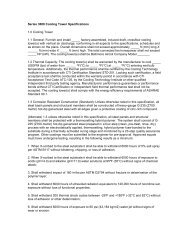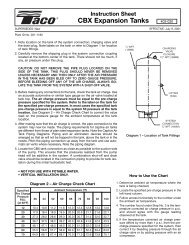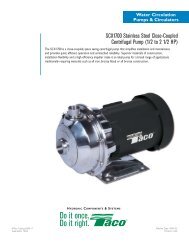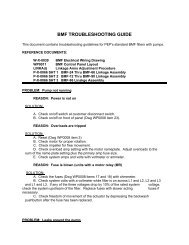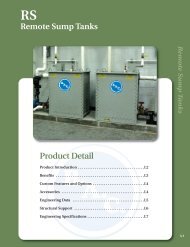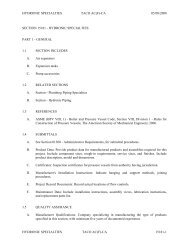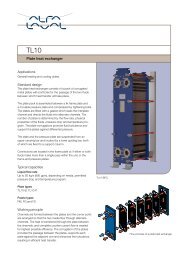1600 Series In-Line Pump - Taco-Hvac
1600 Series In-Line Pump - Taco-Hvac
1600 Series In-Line Pump - Taco-Hvac
- No tags were found...
You also want an ePaper? Increase the reach of your titles
YUMPU automatically turns print PDFs into web optimized ePapers that Google loves.
7.So-called unstable curves are those with maximum headnot at zero, but at 5 to 25 percent of maximum flow, asshown by the curve for <strong>Pump</strong> 1 in Fig. 3 – 1.The term unstable, though commonly used, is ratherunfortunate terminology in that it suggests unstable pumpperformance. Neither term refers to operating characteristic,however. Each is strictly a designation for a particular shapeof curve. Both stable and unstable curves have advantagesand disadvantages in design and application. It is left to thediscretion of the designer to determine the shape of hiscurve.Single <strong>Pump</strong> <strong>In</strong> OpenSystem With Static Head<strong>In</strong> an open system with static head, the resistance curveoriginates at zero flow and at the static head to beovercome. The flow is again given by the intersection ofsystem resistance and pump curves as illustrated for astable curve in Fig. 3–2.2<strong>In</strong> a vast majority of installations, whether the pump curveis stable or unstable is relatively unimportant, as the followingexamples of typical applications show.Single <strong>Pump</strong> <strong>In</strong> Closed System<strong>In</strong> a closed system, such as a Hydronic heating or coolingsystem, the function of the pump is to circulate the samequantity of fluid over and over again. Primary interest is inproviding flow rate. No static head or lifting of fluid fromone level to another takes place.All system resistance curves originate at zero flow any head.Any pump, no matter how large or small, will produce someflow in a closed system.For a given system resistance curve, the flow produced by anypump is determined by the intersection of the pump curvewith the system resistance curve since only at this point isoperating equilibrium possible. For each combination ofsystem and pump, one and only one such intersection exists.Consequently, whether a pump curve is stable or unstable isof no consequence. This is illustrated in Fig. 3 –1.Fig. 3-23 2It has been said that in an open system with static head acondition could exist where an unstable curve could causethe flow to “hunt” back and forth between two points sincethe system resistance curve intersects the pump curvetwice, as shown in Fig. 3–3. The fallacy of this reasoning lies,in the fact that the pump used for the system in Fig. 3–3already represents an improper selection in that it can neverdeliver any fluid at all. The shutoff head is lower than thestatic head. The explanation for this can be found in themanner in which a centrifugal pump develops its full pressurewhen the motor is started. The very important fact toremember here is that the shutoff head of the pump musttheoretically always be at least equal to the static head.3Fig. 3-1Fig. 3-33 3




